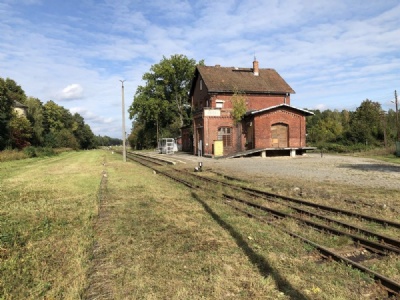Jelowa
About twenty kilometres northeast of Opole in southwestern Poland, there is a small town called Jelowa. Between September, 9-12, 1939, Hitler’s special train, America, was parked at the town’s small station. On September 3, 1939, two days after Germany invaded Poland, Hitler traveled to Poland in his special train (Führersonderzug), America, to follow the German campaign against Poland at closer range. Hitler traveled to different places from, where he either by plane or car, visited different front sections. On September 9, the train arrived in Jelowa where Hitler stayed until September 12. From Jelowa, Hitler and his entourage made visits closer to the front and had both military and political deliberations at the station. One reason for choosing Jelowa as a temporary headquarters was its proximity to the german border.
Hitler’s trains was officially named America in January, 1940, but after Germany declared war on the United States in December 1941, the name was changed to Brandenburg in January, 1942. The train was well equipped and well armored and had a luxurious interior with comfortable bedrooms, bathroom, guest room, casino, conference room, press room, communication center, kitchen, dining room, crew room, press room, hairdresser as well as a carriage with his personal car. It was also equipped with two locomotives in case one of them for what ever reason broke down.
The advantage of a mobile headquarters is it’s mobility to quickly move between different locations if the situation so required. The downside was that the train was quite exposed, even though it was well armed and surrounded by a high level of security wherever it traveled. A stationary headquarters was not as exposed as a mobile one. Another disadvantage was that it was difficult to gather all the various military departments for discussions about war and warfare. A stationary headquarters could house all departments in the same area and could therefore be called up quickly if necessary. Therefore, when Hitler and Germany invaded Western Europe in spring1940, a stationary headquarters in western Germany had been built in advance called Felsennest.
But in connection with the rapid campaign against the Balkans in April, 1941, America was reintroduced as a headquarters when there was simply no time to establish a stationary headquarters. This time, the headquarters in Mönichkirchen, Austria, was located next to an existing railway tunnel in case of air strikes. Hitler, however, came to use both America and Brandenburg for travel throughout the war. Not only back and forth headquarters but also to other places in occupied Europe. The last time Hitler traveled with his special train was when he returned to Berlin in January, 1945, after the failure of the Ardenner offensive.
Current status: Preserved (2023).
Location: 50°47' 39.95" N 18°02' 50.03" E
Get there: Car.
Follow up in books: Seidler, Franz W. & Zeigert, Dieter: Hitler’s secret headquarters (2004).








The station has long been closed and shut downed, but still spared from vandalism. Tracks and platforms remains, although not as many tracks as when Hitler’s train was there and now surrounded by bushes and smaller trees. The main platform is also there, although a little bit worn down after being more or less abandoned for decades. But together, this creates a historical presence that in my opinion makes history more interesting. The fact that there are photographs taken of Hitler and his entourage makes it extra interesting to place yourself not only at the photographer’s spot, but also the subject’s spot.